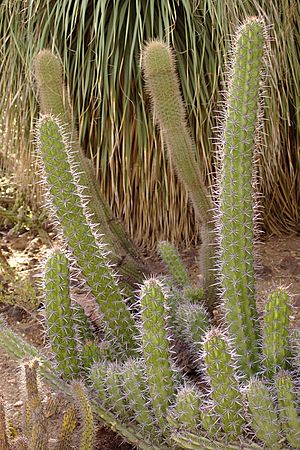Stenocereus gummosus facts for kids
Quick facts for kids Stenocereus gummosus |
|
|---|---|
 |
|
| Conservation status | |
| Scientific classification | |
| Genus: |
Stenocereus
|
| Species: |
gummosus
|
| Synonyms | |
|
|
Stenocereus gummosus is a special kind of cactus that grows in the desert areas of Baja California, Mexico. It's also known by its common names, like Sour Pitahaya or Pitahaya Agria, because of its tasty, tart fruit. This amazing plant is part of the Cactaceae family, which includes all cacti. It can be found growing in dry, sunny places, usually at elevations from about 9 to 134 meters above sea level.
Contents
What is Stenocereus gummosus?
Stenocereus gummosus is a large, branching cactus that can grow quite tall. Its stems are covered in sharp spines, which help protect it from animals. These cacti often form dense thickets, creating a unique landscape in the desert.
Appearance and Features
This cactus has several ribbed stems that grow upwards from its base. The stems are usually green or bluish-green. Along these ribs are clusters of spines that can be quite long and sharp.
Its Spines
The spines on Stenocereus gummosus are not just for show! They help protect the cactus from animals that might want to eat it. Spines also help collect dew and moisture from the air, directing it down to the plant's roots. They also provide some shade, protecting the cactus from the intense desert sun.
Beautiful Flowers
During certain times of the year, usually in late spring or early summer, Stenocereus gummosus produces beautiful, large flowers. These flowers are often white or pinkish and typically open at night. They have a sweet smell that attracts pollinators.
The Sour Pitahaya Fruit
After the flowers are pollinated, they develop into a round or oval-shaped fruit. This fruit is often bright red or purple when ripe. It's known as "sour pitahaya" because of its tart, refreshing taste. The fruit is filled with small, black seeds and juicy pulp.
Where Does It Grow?
Stenocereus gummosus is native to the Baja California Peninsula in Mexico. This region has a desert climate, meaning it's very hot and dry for most of the year. The cactus is well-adapted to these harsh conditions. It prefers sandy or rocky soils and needs lots of sunlight to thrive.
How Does It Reproduce?
Like many flowering plants, Stenocereus gummosus reproduces through its flowers and seeds.
Pollination
Since its flowers open at night, they are often pollinated by nocturnal (night-active) creatures. Bats and moths are common visitors to these flowers. They drink the nectar and, in doing so, carry pollen from one flower to another, helping the plant make seeds.
Seed Dispersal
Once the fruit ripens, it becomes a tasty treat for many desert animals, including birds, rodents, and even humans. When these animals eat the fruit, they help spread the seeds. The seeds pass through their digestive systems and are then deposited in new locations, ready to grow into new cacti if conditions are right.
Importance to Nature and People
Stenocereus gummosus plays an important role in its desert ecosystem.
Food for Wildlife
The fruit of this cactus is a vital food source for many desert animals. Birds, bats, and small mammals rely on the fruit for moisture and nutrients, especially during dry periods. The flowers also provide nectar for pollinators.
Food for Humans
For centuries, the indigenous people of Baja California have harvested and eaten the sour pitahaya fruit. It can be eaten fresh, or used to make drinks, jams, and other foods. It's a valuable wild food source for local communities.
See also
 In Spanish: Stenocereus gummosus para niños
In Spanish: Stenocereus gummosus para niños


